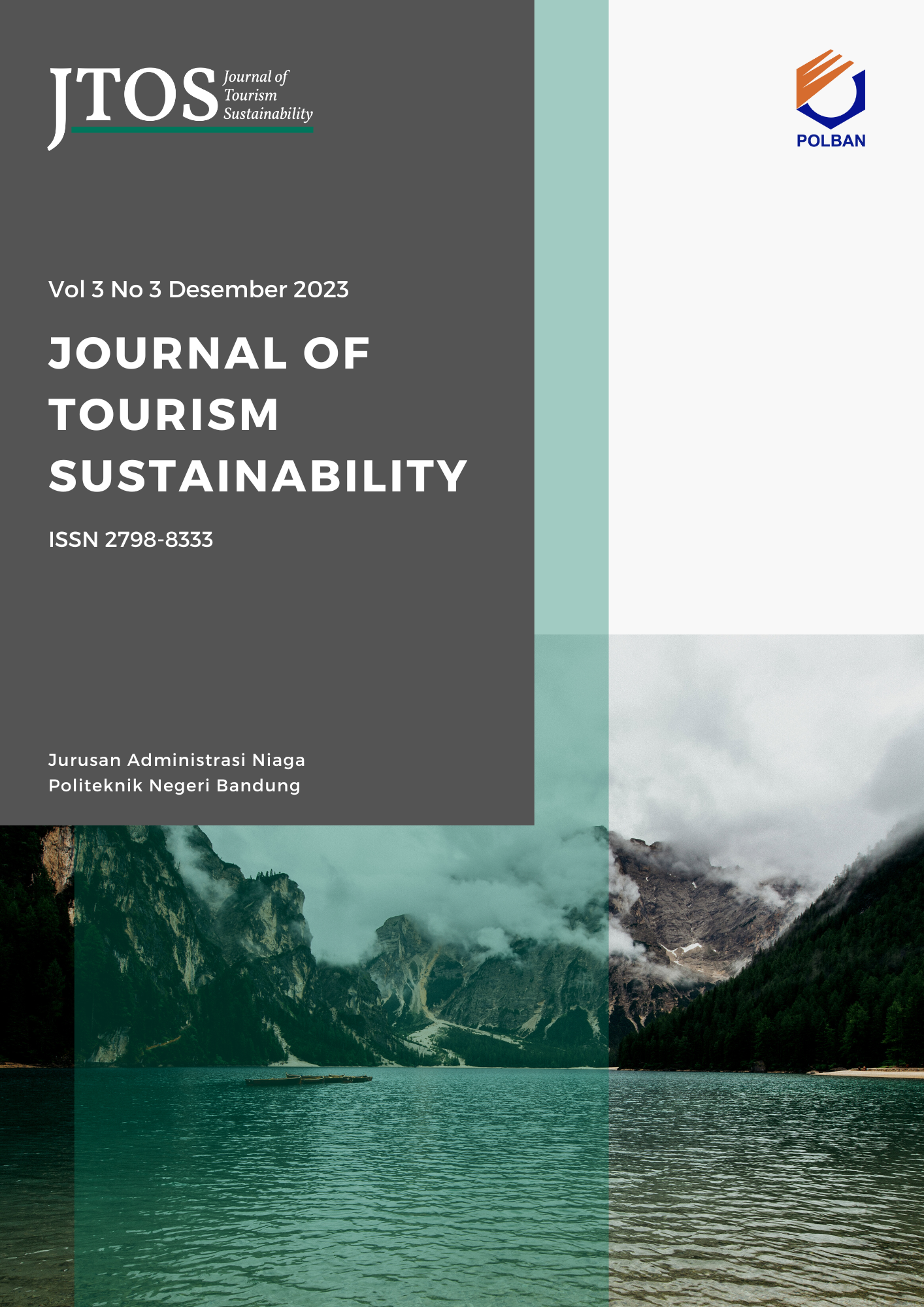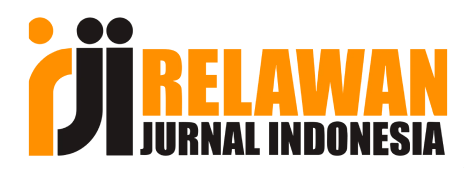Evaluating The Effectiveness of Physical and Economic Management Strategies on the Sustainability of Tourist Attractions in Ol Pejeta Conservancy, Laikipia County, Kenya
DOI:
https://doi.org/10.35313/jtospolban.v5i1.141Keywords:
Sustainability, Visitor Management, Physical Strategies, Economic Strategies, Tourist AttractionsAbstract
Sustainability is an essential strategic concept for tourist attractions. However, the current rise in visitor numbers globally threatens this concept. This calls not only for the need to implement relevant visitor management strategies to oversee these numbers but also to ensure that the adopted strategies effectively facilitate proper visitor behaviour. Ol Pejeta Conservancy, Kenya, is a key tourist attraction that upholds sustainability as its strategic concept. However, the rise in visitor numbers over the past five years threatens the sustainability aspects of the site. Hence, using this site as a case study, this paper aims to assess the effectiveness of two major visitor management strategies - physical and economic - on the sustainability of tourist attractions. The study initially targeted 227 visitors, from whom 167 completed and returned the questionnaires. The collected data were analysed statistically using multiple linear regression. Results reveal that physical and economic management strategies play a crucial role in ensuring the sustainability of tourist attractions. Thus, they offer actionable insights to tourism managers in similar settings to implement effective strategies for sustainable efforts in tourist attractions.
References
Albrecht, J.N. ed., 2017. Visitor management in tourism destinations. CABI.
Asmelash, A. G., & Kumar, S. (2019). Assessing progress of tourism sustainability: Developing and validating sustainability indicators. Tourism Management, 71, 67-83. https://doi.org/10.1016/j.tourman.2018.09.020
Ballantyne, R., Slabbert, L., Packer, J. & Sneddon, J., (2023). Negotiating stakeholder solutions to complex visitor management problems: the case of traffic management in the Kruger National Park. Transactions of the Royal Society of South Africa, 78(3), pp.197-206.doi/full/10.1080/0035919X.2023.2214105
Bak, I., & Szczecinska, B. (2020). Global demographic trends and effects on tourism.
Bartula, M., & Radun, V. (2020). Visitor management planning as a tool for sustainable tourism in protected areas in Serbia. In Tourism International Scientific Conference Vrnjačka Banja-TISC (Vol. 5, No. 1, pp. 77-93). http://www.tisc.rs/proceedings/index.php/hitmc/article/view/330
Cheung, L.T., (2013). November. Improving visitor management approaches for the changing preferences and behaviors of country park visitors in Hong Kong. In Natural resources forum (Vol. 37, No. 4, pp. 231-241). doi.org/10.1111/1477-8947.12025
Demas, M., Agnew, N., Fan, J., & Maekawa, S. (2015). Strategies for sustainable tourism at the Mogao Grottoes of Dunhuang, China. Cham: Springer International Publishing.
Enseñat-Soberanis, F., Frausto-Martínez, O. & Gándara-Vázquez, M., (2019). A visitor flow management process for touristified archaeological sites. Journal of Heritage Tourism, 14(4),pp.340-357. doi.org/10.1080/1743873X.2018.1529179
Eyassu, A.W., Asefa, G.M. & Atlug, A., (2021). Practices and challenges of visitor management implementation for sustainable tourism development in Fasil Ghebbi, Ethiopia. Journal of Hospitality Management and Tourism, 12(1), pp.1-8. doi.org/10.5897/JHMT2020.0294
Holmes, A.P., Grimwood, B.S. & King, L.J., (2019). Creating an Indigenized visitor code of conduct: The development of Denesoline self-determination for sustainable tourism. In Sustainable Tourism and Indigenous Peoples (pp. 111-127). Routledge.
Ireri, P., Kung’u, J. B., & Muriithi, J. K. (2020). Distribution of the Benefits of Ngare Ndare Forest Trust and Il Ngwesi Group Ranch Ecotourism Enterprises in Kenya. African Journal of Hospitality, Tourism and Leisure, 9(5), 1178-1192.
Jodłowski, M., Kruczek, Z., Szromek, A. & Gmyrek, K., (2023). Tourists’ Attitudes towards visitor management and restrictions in the National Parks in the Carpathian Mountains. Studia Periegetica, 42(2), pp.7-30. doi.org/10.58683/sp.385
Juma, L.O., Bakos, I.M. & Khademi-Vidra, A., (2020). Nature interpretation and visitor management objectives: A survey of tourist attitudes at Maasai Mara National Reserve, Kenya. Sustainability, 12(18), p.7246.doi.org/10.3390/su12187246
Kabiru, A. (2009). Lamu: Is sustainable cultural tourism possible?. Kenya Past and Present, Tourism and Leisure, 9(5):1178-1192.
DOI: https://doi.org/10.46222/ajhtl.19770720-76 38(1), 43-49.
Kebete, Y. & Wondirad, A., (2019). Visitor management and sustainable destination management nexus in Zegie Peninsula, Northern Ethiopia. Journal of Destination Marketing & Management, 13, pp.83-98. doi.org/10.1016/j.jdmm.2019.03.006
Kişi, N., (2019). A strategic approach to sustainable tourism development using the A’WOT hybrid method: A case study of Zonguldak, Turkey. Sustainability, 11(4), p.964. doi.org/10.3390/su11040964
KWS (Kenya Wildlife Service). (2018). Wildlife conservation policies and management. Nairobi: KWS.
Leung, Y. F., Spenceley, A., Hvenegaard, G., Buckley, R., & Groves, C. (2018). Tourism and visitor management in protected areas: Guidelines for sustainability (Vol. 27). Gland, Switzerland: IUCN.
Maingi, S.W., (2019). Sustainable tourism certification, local governance and management in dealing with overtourism in East Africa. Worldwide Hospitality and Tourism Themes, 11(5), pp.532-551. doi.org/10.1108/WHATT-06-2019-0034
Mason, P., (2020). Tourism impacts, planning and management. Routledge.
Ministry of Tourism and Wildlife (2022). New Tourism Strategy for Kenya 2021-2025. https://tourism.go.ke/wp-content/uploads/2022/10/New-Tourism-Strategy-for-Kenya-2021-2025.pdf
Murungi, T. M. (2020). Determinants of Sustainability of Community Based Ecotourism Development Projects in Kenya. A Case of Northern Rangeland Trust Conservancy, Meru County (Doctoral dissertation, University of Nairobi).
Mwangi, F., Zhang, Q. & Wang, H., (2022). Development challenges and management strategies on the Kenyan National Park System: A case of Nairobi National Park. International Journal of Geoheritage and Parks, 10(1), pp.16-26. doi.org/10.1016/j.ijgeop.2022.02.003
Ol Pejeta Conservancy. (2022). Annual report. https://www.olpejetaconservancy.org/about-us/our-story/annual-report/
Ol Pejeta Conservancy. (2024). Ol-Pejeta-Tariff-Guide-9th-Aug-2023-to-31st-Dec-2024-.pdf. https://www.olpejetaconservancy.org/uplo ads/assets/uploads/2023/08/
Panić, A., Pavlakovič, B. & Koščak, M., (2019). Managing a sustainable tourism destination. In Ethical and Responsible Tourism (pp. 359-374). Routledge. doi:10.33422/ime.2018.12.74
Petrić, L., & Mandić, A. (2014). Visitor management tools for protected areas focused on sustainable tourism development: the Croatian experience. Environmental engineering and management journal, 13(6), 1483-1495.
Qaddhat, R.M., Fayed, H.A. & Wafik, G.M., (2021). Evaluation of visitor management and its impact on visitor experience and satisfaction at Archaeological sites in Jordan (case study: Jerash). Academic Journal of Interdisciplinary Studies, 10(1), p.248. https://doi.org/10.36941/ajis-2021-0022
Shah, P.S. & Irandu, E., (2022). Recreational green spaces as the future for sustainable cities: Case of Karura Forest in Nairobi, Kenya. Journal of Sustainability, Environment and Peace, pp.87-95. https://doi.org/10.53537/jsep.2022.06.001
Spenceley, A. (2014). Benefit sharing from natural heritage: Examples and challenges from Africa. In Presentation at the Inkasa Symposium, Cape Town, South Africa, April.
Spenceley, A., Kohl, J., McArthur, S., Myles, P., Notarianni, M., Paleczny, D., Pickering, C. & Worboys, G.L.,(2015). Visitor management. Protected area governance and management, pp.715-750.
Tien, N.H., Viet, P.Q., Duc, N.M. & Tam, V.T., (2021). Sustainability of tourism development in Vietnam's coastal provinces. World Review of Entrepreneurship, Management and Sustainable Development, 17(5), pp.579-598. https://doi: 10.1504/wremsd.2021.117443
Tourism Research Institute (2023). Kenya Annual Tourism Sector Perfomance Report 2022.https://tri.go.ke/wp-content/uploads/2023/02/Tourism-Sector-Performance-Report_2022.pdf
United Nations World Tourism Organization (2020). International tourism highlights 2020 edition. https://www.unwto.org/covid-19-and-tourism-2020
United Nations World Tourism Organization (2023). Tourism on track for full recovery as new data shows strong start to 2023. Accessed from https://www.unwto.org/news/tourism-on-track-for-full-recovery-as-new-data-shows-strong-start-to-2023
Wawire, C. R., Muriuki, L. M., & Nkari, I. M. (2023). eajhlt. https://doi.org/10.5281/zenodo.7849167
Wong, C.U.I., McIntosh, A. & Ryan, C., (2016). Visitor management at a Buddhist sacred site. Journal of Travel Research 55(5), pp. 675-687. https://doi.org/10.1177/0047287514563164
Downloads
Published
Issue
Section
License
Copyright (c) 2025 Lucy Wanjiru Mwangi, Erick Fwaya, Gilbert Miriti

This work is licensed under a Creative Commons Attribution-NonCommercial-ShareAlike 4.0 International License.



.png)

















